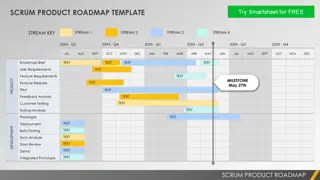
Understanding the Scrum of Scrums Scaling Agile
As Agile methodologies like Scrum become widely adopted, many organizations face the challenge of scaling these practices across multiple teams working on complex projects.
Download Presentation

Please find below an Image/Link to download the presentation.
The content on the website is provided AS IS for your information and personal use only. It may not be sold, licensed, or shared on other websites without obtaining consent from the author. Download presentation by click this link. If you encounter any issues during the download, it is possible that the publisher has removed the file from their server.
E N D
Presentation Transcript
Understanding the Scrum of Scrums: Scaling Agile As Agile methodologies like Scrum become widely adopted, many organizations face the challenge of scaling these practices across multiple teams working on complex projects. While Scrum works effectively for small, self-organizing teams, larger enterprises often need to coordinate between multiple teams working on different parts of the same product. This is where Scrum of Scrums (SoS) comes into play. Scrum of Scrums is a scalable technique designed to maintain Agile practices across multiple teams while ensuring seamless communication, collaboration, and alignment. Let s explore what Scrum of Scrums is, how it works, and why it s essential for scaling Agile. What is Scrum of Scrums? Scrum of Scrums is a framework that allows multiple Scrum teams to work together while maintaining the core principles of Agile. Each Scrum team continues to follow its own Sprint cycles, Daily Standups, Sprint Reviews, and Retrospectives, but they also engage in the Scrum of Scrums meeting, where representatives from each team gather to coordinate, discuss progress, and resolve inter-team dependencies. The main goal of Scrum of Scrums is to scale Agile principles without compromising the flexibility, collaboration, and rapid iteration that Scrum promotes. It helps align teams working on different parts of a project and ensures that their work is integrated and progressing smoothly. How Scrum of Scrums Works The key element of Scrum of Scrums is the Scrum of Scrums Meeting (SoSM). Here s how it typically works: 1.Selecting Representatives: Each Scrum team nominates a representative, often the Scrum Master or a senior team member, to attend the Scrum of Scrums meeting. This person is responsible for reporting on the team s progress and discussing challenges or blockers. 2.Regular Meetings: Scrum of Scrums meetings are typically held daily or at regular intervals. They are structured like traditional Scrum Daily Standups but involve representatives from different teams. 3.Information Sharing: In these meetings, each representative answers four key questions: oWhat did my team accomplish since the last Scrum of Scrums? oWhat will my team do before the next Scrum of Scrums? oWhat obstacles or dependencies does my team face that could affect other teams? oWhat is our team s progress toward the larger goal or release? 4.Resolving Dependencies: One of the primary functions of Scrum of Scrums is to identify and resolve inter-team dependencies. If one team s work impacts another s, the Scrum of Scrums meeting is the place to discuss and address those challenges.
5.Escalating Issues: If an issue arises that cannot be resolved at the team level, it is escalated during the Scrum of Scrums meeting. This allows for faster resolution of critical blockers that affect multiple teams. Benefits of Scrum of Scrums 1.Improved Coordination: In large projects, it s easy for teams to lose track of what others are doing. Scrum of Scrums ensures that teams are aligned and aware of each other s progress, reducing the risk of miscommunication or duplicated efforts. 2.Faster Issue Resolution: By providing a forum for teams to discuss dependencies and blockers, Scrum of Scrums helps identify issues early. This allows for quicker resolutions, ensuring that work continues smoothly across teams. 3.Transparency and Accountability: Scrum of Scrums creates a level of transparency across teams. Each representative is accountable for their team s progress and can be held responsible for reporting on delays or obstacles. 4.Scaling Agile without Losing Focus: Scrum of Scrums allows large organizations to scale Agile without losing the benefits of small, focused teams. Each Scrum team continues to work independently, but the SoS framework ensures they remain aligned with the overall project goals. Best Practices for Implementing Scrum of Scrums 1.Keep Meetings Short: Like the Daily Standup, Scrum of Scrums meetings should be short and to the point. Focus on progress, blockers, and dependencies rather than detailed technical discussions. 2.Ensure Clear Communication: Representatives should clearly and concisely convey their team s updates. This requires preparation before attending the meeting to ensure accurate reporting. 3.Address Dependencies Early: Encourage teams to identify and discuss inter-team dependencies as early as possible. This proactive approach prevents delays later in the sprint. 4.Escalate Only When Necessary: Not every issue needs to be brought to the Scrum of Scrums meeting. Teams should attempt to resolve problems internally first, escalating only when necessary. When to Use Scrum of Scrums Scrum of Scrums is particularly useful in the following scenarios: Large Projects: When multiple teams are working on different aspects of the same product or project, Scrum of Scrums provides a way to coordinate efforts. Distributed Teams: If teams are spread across different locations, Scrum of Scrums helps maintain alignment and coordination. Cross-Functional Teams: When teams from different disciplines (e.g., development, QA, UX) need to collaborate, Scrum of Scrums facilitates communication and dependency management.
Conclusion Scrum of Scrums is an effective way to scale Agile practices across multiple teams, ensuring alignment, collaboration, and efficient communication. By providing a structured framework for coordinating large projects, Scrum of Scrums helps organizations maintain the agility and flexibility of Scrum, even at scale. Whether your organization is managing large-scale software development or complex, cross-functional projects, Scrum of Scrums can be a valuable tool for keeping teams focused and aligned toward shared goals. Read More: https://techhorizonsolutions.blogspot.com/2024/09/understanding-scrum-of-scrums- scaling.html
















































